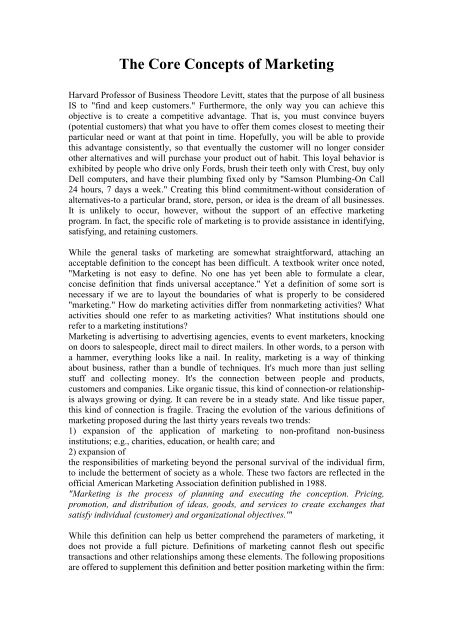The Core Concepts of Marketing
The Core Concepts of Marketing
The Core Concepts of Marketing
You also want an ePaper? Increase the reach of your titles
YUMPU automatically turns print PDFs into web optimized ePapers that Google loves.
<strong>The</strong> <strong>Core</strong> <strong>Concepts</strong> <strong>of</strong> <strong>Marketing</strong><br />
Harvard Pr<strong>of</strong>essor <strong>of</strong> Business <strong>The</strong>odore Levitt, states that the purpose <strong>of</strong> all business<br />
IS to "find and keep customers." Furthermore, the only way you can achieve this<br />
objective is to create a competitive advantage. That is, you must convince buyers<br />
(potential customers) that what you have to <strong>of</strong>fer them comes closest to meeting their<br />
particular need or want at that point in time. Hopefully, you will be able to provide<br />
this advantage consistently, so that eventually the customer will no longer consider<br />
other alternatives and will purchase your product out <strong>of</strong> habit. This loyal behavior is<br />
exhibited by people who drive only Fords, brush their teeth only with Crest, buy only<br />
Dell computers, and have their plumbing fixed only by "Samson Plumbing-On Call<br />
24 hours, 7 days a week." Creating this blind commitment-without consideration <strong>of</strong><br />
alternatives-to a particular brand, store, person, or idea is the dream <strong>of</strong> all businesses.<br />
It is unlikely to occur, however, without the support <strong>of</strong> an effective marketing<br />
program. In fact, the specific role <strong>of</strong> marketing is to provide assistance in identifying,<br />
satisfying, and retaining customers.<br />
While the general tasks <strong>of</strong> marketing are somewhat straightforward, attaching an<br />
acceptable definition to the concept has been difficult. A textbook writer once noted,<br />
"<strong>Marketing</strong> is not easy to define. No one has yet been able to formulate a clear,<br />
concise definition that finds universal acceptance." Yet a definition <strong>of</strong> some sort is<br />
necessary if we are to layout the boundaries <strong>of</strong> what is properly to be considered<br />
"marketing." How do marketing activities differ from nonmarketing activities? What<br />
activities should one refer to as marketing activities? What institutions should one<br />
refer to a marketing institutions?<br />
<strong>Marketing</strong> is advertising to advertising agencies, events to event marketers, knocking<br />
on doors to salespeople, direct mail to direct mailers. In other words, to a person with<br />
a hammer, everything looks like a nail. In reality, marketing is a way <strong>of</strong> thinking<br />
about business, rather than a bundle <strong>of</strong> techniques. It's much more than just selling<br />
stuff and collecting money. It's the connection between people and products,<br />
customers and companies. Like organic tissue, this kind <strong>of</strong> connection-or relationshipis<br />
always growing or dying. It can revere be in a steady state. And like tissue paper,<br />
this kind <strong>of</strong> connection is fragile. Tracing the evolution <strong>of</strong> the various definitions <strong>of</strong><br />
marketing proposed during the last thirty years reveals two trends:<br />
1) expansion <strong>of</strong> the application <strong>of</strong> marketing to non-pr<strong>of</strong>itand non-business<br />
institutions; e.g., charities, education, or health care; and<br />
2) expansion <strong>of</strong><br />
the responsibilities <strong>of</strong> marketing beyond the personal survival <strong>of</strong> the individual firm,<br />
to include the betterment <strong>of</strong> society as a whole. <strong>The</strong>se two factors are reflected in the<br />
<strong>of</strong>ficial American <strong>Marketing</strong> Association definition published in 1988.<br />
"<strong>Marketing</strong> is the process <strong>of</strong> planning and executing the conception. Pricing,<br />
promotion, and distribution <strong>of</strong> ideas, goods, and services to create exchanges that<br />
satisfy individual (customer) and organizational objectives.'"<br />
While this definition can help us better comprehend the parameters <strong>of</strong> marketing, it<br />
does not provide a full picture. Definitions <strong>of</strong> marketing cannot flesh out specific<br />
transactions and other relationships among these elements. <strong>The</strong> following propositions<br />
are <strong>of</strong>fered to supplement this definition and better position marketing within the firm:
1. <strong>The</strong> overall directive for any organization is the mission statement or some<br />
equivalent statement <strong>of</strong> organizational goals. It reflects the inherent business<br />
philosophy <strong>of</strong> the organization.<br />
2. Every organization has a set <strong>of</strong> functional areas (e.g., accounting, production,<br />
finance, data processing, marketing) in which tasks are necessary for the success <strong>of</strong><br />
the organization are performed. <strong>The</strong>se functional areas must be managed if they are to<br />
achieve maximum performance.<br />
3. Every functional area is guided by a philosophy (derived from the mission<br />
statement or company goals) that governs its approach toward its ultimate set <strong>of</strong> tasks.<br />
4. <strong>Marketing</strong> differ~ from the other functional areas in that its primary concern is with<br />
exchanges that take place in markets, outside the organization (called a transaction).<br />
5. <strong>Marketing</strong> is most successful when the philosophy, tasks, and manner <strong>of</strong><br />
implementing available Technology are coordinated and complementary.<br />
Perhaps an example will clarify these propositions: L.L. Bean is an extremely<br />
successful mail order company. <strong>The</strong> organization bases much <strong>of</strong> its success on its<br />
longstanding and straightforward mission statement: "Customer Satisfaction: An L.L.<br />
Bean Tradition" (Proposition 1). <strong>The</strong> philosophy permeates every level <strong>of</strong> the<br />
organization and is reflected in high quality products, fair pricing, convenience, a<br />
100% satisfaction policy and-above all-dedication to customer service (Proposition 2).<br />
This philosophy has necessitated a very high standard <strong>of</strong> production, efficient billing<br />
systems, extensive and responsive communication networks, computerization,<br />
innovative cost controls, and so forth. Moreover, it has meant that all <strong>of</strong> these<br />
functional areas have to be in constant communication, must be totally coordinated,<br />
and must exhibit a level <strong>of</strong> harmony and mutual respect that creates a positive<br />
environment in order to reach shared goals (Proposition 3).<br />
<strong>The</strong> L.L. Bean marketing philosophy is in close harmony with its mission statement.<br />
Everything the marketing department does must reinforce and make real the abstract<br />
concept <strong>of</strong> "consumer satisfaction" (Proposition 4). <strong>The</strong> price-product-quality<br />
relationship must be fair. <strong>The</strong> product must advertise in media that reflects trust high<br />
quality.<br />
Consequently, L.L. Bean advertises through its direct-mail catalogue and through<br />
print ads in prestigious magazines (e.g. , National Geographic). It also has one <strong>of</strong> the<br />
most highly regarded websites (Ad 1.1). Product selection and design are based upon<br />
extensive research indicating the preferences <strong>of</strong> their customers Since product<br />
delivery and possible product return is critical, marketing must be absolutely sure that<br />
both these tasks are performed in accordance with customers' wishes (Proposition 5).<br />
While one might argue that the marketing function must be the most important<br />
function at L.L. Bean, this is root the case. L.L. Bean is just as likely to lose a<br />
customer because <strong>of</strong> incorrect billing (an accounting function) or a flawed hunting<br />
boot (a product function) as it is from a misleading ad (a marketing function).<br />
Admittedly, marketing is <strong>of</strong>ten a critical part <strong>of</strong> a firm's success. Nevertheless, the<br />
importance <strong>of</strong> marketing must be kept in perspective. For many large manufacturers<br />
such as Proctor & Gamble, Micros<strong>of</strong>t, Toyota, and Sanyo, marketing represents a<br />
major expenditure, and these businesses depend on the effectiveness <strong>of</strong> their<br />
marketing effort. Conversely, for regulated industries (such as utilities, social<br />
services, or medical care or small businesses providing a one-<strong>of</strong>-a-kind product)<br />
marketing may be little more than a few informative brochures. <strong>The</strong>re are literally<br />
thousands <strong>of</strong> examples <strong>of</strong> businesses-many quite small that have neither the resources
nor the inclination to support an elaborate marketing organization and strategy. <strong>The</strong>se<br />
businesses rely less on research than on common sense. In all these cases the<br />
marketing program is worth the costs only if it fits the organization and facilitates its<br />
ability to reach its goals.<br />
<strong>Marketing</strong> today is a way <strong>of</strong> doing business, not just merely a function or acts <strong>of</strong><br />
selling and advertising as many <strong>of</strong>ten perceive marketing. It is involved in every<br />
major activity a business has and it should be practiced by every employee in the<br />
company, not just the management. In other words marketing is an essential part <strong>of</strong><br />
successful business and cannot be ignored.<br />
In short, as Kotler et al. describes marketing, ‘it’s a philosophy a way <strong>of</strong> thinking and<br />
a way <strong>of</strong> structuring your business and your mind’ (Kotler et al. 2003).<br />
Traditionally marketing has developed to concern more about tangible products than<br />
services. Even the first definitions <strong>of</strong> marketing included only physical products.<br />
Today, however, the service industry, where tourism industry is also included, is in<br />
growth accounting a large part <strong>of</strong> GDP in several countries and the definitions <strong>of</strong><br />
marketing must be revised to concern intangible products i.e. services as well. <strong>The</strong>se<br />
services include also tourism and hospitality industry such as rural tourism in Finland.<br />
Another Definition <strong>of</strong> <strong>Marketing</strong><br />
<strong>Marketing</strong> has been defined in many ways – at least as many as there are people<br />
defining it. <strong>The</strong>re are, however, according to for example Seaton and Bennett five<br />
common features to all <strong>of</strong> these definitions. <strong>Marketing</strong> is:<br />
A philosophy <strong>of</strong> consumer orientation;<br />
A number <strong>of</strong> analytical procedures and concepts;<br />
Data- gathering techniques;<br />
A sequence <strong>of</strong> strategic decision areas and planning functions;<br />
An organisational structure for implementation <strong>of</strong> the planning. (Seaton & Bennett,<br />
1996, 7)<br />
One <strong>of</strong> the most reliable and comprehensive definitions for marketing is made by<br />
Philip Kotler, a respected pr<strong>of</strong>essor <strong>of</strong> International <strong>Marketing</strong> at the Kellogg<br />
Graduate School <strong>of</strong> Management. He has written, together with other experts, several<br />
books about marketing and can be said that he knows his business. In his book <strong>of</strong><br />
<strong>Marketing</strong> for Hospitality and Tourism marketing has been defined as (Kotler et al.,<br />
2003, 13):<br />
<strong>Marketing</strong> = a social and managerial process by which individuals and groups<br />
obtain what they need and want through creating and exchanging products and value<br />
with others.<br />
<strong>Marketing</strong> is, despite the fact that today it is more a general business philosophy, still<br />
a function which needs to be managed, not only by a marketing manager but all the<br />
people involved in marketing analysis, planning, implementation or control activities.<br />
<strong>Marketing</strong> management there has also its own definition, from which once more<br />
Kotler’s definition is the most common one:<br />
<strong>Marketing</strong> management = the analysis, planning, implementation, and control <strong>of</strong><br />
programs designed to create, build, and maintain beneficial exchanges with target<br />
buyers for the purpose <strong>of</strong> achieving organizational objectives.
In other words marketing managers task is to control demand to fit the company<br />
objectives and capacity and thus can also be called demand management.<br />
This management must be carried out under an appropriate philosophy according to<br />
the emphasized interest. <strong>The</strong>re are five different philosophy concepts a marketing<br />
management <strong>of</strong> an organization can follow.<br />
<strong>The</strong>se are manufacturing, product, selling, marketing and societal marketing concept.<br />
In today’s business marketing concept is widely used and well adopted in the<br />
hospitality industry. In marketing concept the customers’ needs and wants are<br />
emphasized and the aim <strong>of</strong> the company is to meet those needs and wants effectively<br />
and efficiently. (Kotler et al. 2003, 23-24.)<br />
<strong>The</strong> <strong>Core</strong> <strong>Concepts</strong> <strong>of</strong> <strong>Marketing</strong><br />
In marketing there are some concepts that are the core <strong>of</strong> marketing. <strong>The</strong>se are: needs<br />
and wants, demands, products, exchange, transactions, relationships and markets.<br />
<strong>The</strong> very basic in marketing are consumers’ needs, wants and demands. Without these<br />
business and marketing would not exist. <strong>The</strong> needs <strong>of</strong> people consists physical needs,<br />
social needs, esteem needs, and individual needs. Usually in developed countries the<br />
basic needs <strong>of</strong> people have already been fulfilled and the needs to be fulfilled are from<br />
the social and esteem levels. <strong>The</strong> levels <strong>of</strong> needs are well explained by Maslow’s<br />
hierarchy <strong>of</strong> needs. Wants on the other hand are derived from needs and they are<br />
shaped by personality and culture. It is how needs are communicated. Beyond wants<br />
there are demands which mean basically wants limited by buying power. (Kotler et<br />
al., 2003, 13-15.)<br />
Products and services are for satisfying the needs or wants. Often product is<br />
misunderstood to mean only physical and tangible products although it is anything<br />
that can satisfy a need. Services on the other hand are equivalent to products but<br />
instead <strong>of</strong> products they are intangible activities or services that can be <strong>of</strong>fered to one<br />
party to another and that does not result to ownership <strong>of</strong> something like a product.<br />
With marketing products and services <strong>of</strong>ten is made a mistake <strong>of</strong> selling the physical<br />
products than a solution to a need that the product prides. (Kotler et al. 1999, 11.)<br />
As with needs, wants and demands, also customer value, satisfaction and quality form<br />
a ‘chain’. Customer value means the difference between benefits gained form the<br />
owned or used product and the costs caused by acquisition <strong>of</strong> the product. Customer<br />
satisfaction in turn is dependable on product’s perceived performance in relation to<br />
customers’ expectations.<br />
Customers’ expectations can be very different from each others since they are based<br />
on matters such as previous buying experiences, opinions <strong>of</strong> friends and relatives, and<br />
information received from competitors. Quality ends the chain by being defined<br />
customer satisfaction. High customer satisfaction means also high quality. (Kotler et<br />
al. 2003, 15 – 16.)<br />
Exchange and transactions are the real activities in marketing. Exchange is the<br />
concept in marketing and happens when person has decided to satisfy his needs and<br />
wants, obtains a desired object from someone by <strong>of</strong>fering some thing in return.<br />
Transaction then is the measurement unit <strong>of</strong> marketing, meaning it is a trade <strong>of</strong> values<br />
between two parties. Monetary transaction is a good example <strong>of</strong> it. Relationships are<br />
the consequence from well succeeded trade and it means the process <strong>of</strong> creating,
maintaining and enhancing strong, value- laden relationships with customers and<br />
other stakeholders.<br />
With relationships a marketing network is desired. (Kotler et al. 1999, 12 – 14.)<br />
Markets are the last concepts in the marketing cycle. Market can seem easy to<br />
everyone to understand since it is a word commonly used in marketing.<br />
In fact market derives from the concept <strong>of</strong> transaction. In short market is a set <strong>of</strong><br />
actual and potential buyers who might transact with a seller. Before this meant a<br />
physical location <strong>of</strong> village for example but nowadays as a result from advanced<br />
technology markets can scattered all around the world or they can be groupings <strong>of</strong><br />
people named after the core need, such as need markets, product markets or<br />
geographic markets. (Kotler et al. 1999, 14 – 15.)<br />
<strong>The</strong> <strong>Marketing</strong> Process<br />
Every company that wants to do a successful marketing has to go through a marketing<br />
process. This process is a set <strong>of</strong> stages where starting from segmentation and ending<br />
with positioning your product and company in the selected markets. <strong>The</strong>re are<br />
different versions developed from this process from which the one made by Lesley<br />
Pender is next gone through stage by stage. This process covers the same phases as<br />
the process made by Philip Kotler but slightly shortened.<br />
1) Segmentation <strong>of</strong> the overall market. For company to have efficient marketing and to<br />
aim their products to the right consumers, the markets have to be divided into<br />
segments. <strong>The</strong>re are four major segmenting criteria used and they will be discussed<br />
more in chapter 4.<br />
2) Pr<strong>of</strong>iling consumers in each segment. After segmenting company should study and<br />
pr<strong>of</strong>ile the consumers in each market segment in order to find the best consumers to<br />
target.<br />
3) Selection <strong>of</strong> the target markets. After segmenting and pr<strong>of</strong>iling the markets and<br />
customers within, the company should select the appropriate target markets it wishes<br />
to aim at.<br />
4) Development <strong>of</strong> positioning strategies for each segment. In order the company to be<br />
competitive it should position and differentiate its products and itself in relation to<br />
their competitors in the selected markets.<br />
By product positioning the company seeks the desired place for their product in<br />
consumers’ minds whereas by market positioning is looked for a clear, distinctive and<br />
desirable place in relation to competing products in consumers’ minds (Kotler et al.<br />
1999,108).<br />
5) Development <strong>of</strong> a marketing mix for each segment. It is crucial for marketing<br />
process to develop an appropriate marketing mix. <strong>Marketing</strong> mix is, according to<br />
Philip Kotler, ‘the set <strong>of</strong> controllable tactical marketing tools that the firm blends to<br />
produce the response it wants in the target market’ (Kotler et al. 1999, 109). <strong>The</strong> basic<br />
marketing mix tools are the ‘four Ps’ <strong>of</strong> product, price, place, promotion. (Pender<br />
1999, 34 – 36.)<br />
Characteristics <strong>of</strong> a <strong>Marketing</strong> Organization<br />
As noted earlier, the application <strong>of</strong> marketing in a particular organization<br />
varies tremendously, ranging from common-sense marketing to<br />
marketing departments with thousands <strong>of</strong> staff members and<br />
multimillion-dollar budgets. Yet both may have a great deal in common
in respect to how they view the activity called marketing. We refer to<br />
these common characteristics as the Cs <strong>of</strong> <strong>Marketing</strong>. <strong>The</strong>y are your clues<br />
that a business understands marketing.<br />
Consumer Content<br />
What makes the existence <strong>of</strong> any organization possible is that there are a<br />
significant number <strong>of</strong> people who need the product or service <strong>of</strong>fered by<br />
that organization. As soon as that group becomes too small, or the need<br />
no longer exists, or some other organization can satisfy that need better,<br />
the organization will be eliminated. That is the way <strong>of</strong> a free economy.<br />
Thus, a politician doesn't get re-elected, an inner-city church closes its<br />
doors, the money needed to cure AIDS is not allocated, and the Vail Ski<br />
Resort files for bankruptcy.<br />
In the case <strong>of</strong> business organizations, and marketing organization: in<br />
particular, the people with the needs are called consumers or customers.<br />
In marketing, the act <strong>of</strong> obtaining a desired object from someone by<br />
<strong>of</strong>fering something <strong>of</strong> value in return is called the exchange process.<br />
Moreover, the exchange between the person with the need (who gives<br />
money or some other personal resource) and the organization selling this<br />
need-satisfying thing (a product, service, or idea) is inherently economic,<br />
and is called a transaction .<strong>The</strong>re tends to be some negotiation between<br />
the parties. Individuals on both sides attempt to maximize rewards and<br />
minimize costs in their transactions so as to obtain the most pr<strong>of</strong>itable<br />
outcomes. Ideally, all parties achieve a satisfactory level <strong>of</strong> reward.<br />
In each transaction, there is an underlying philosophy in respect to how<br />
the parties perceive the exchange. Sometimes deception and lying<br />
permeate the exchange. Other exchanges may be characterized as<br />
equitable, where each party receives about the same as the other-the<br />
customer's need is satisfied and the business makes a reasonable pr<strong>of</strong>it.<br />
With the emergence <strong>of</strong> the Internet and e-commerce during the 1990s, the<br />
nature <strong>of</strong> the exchange for many businesses and customers has changed<br />
dramatically. Today's consumers have access to far more and far better<br />
information. <strong>The</strong>y also have many more choices. Businesses must<br />
provide a similar level <strong>of</strong> information and must deal with new<br />
competitors that are quicker, smarter, and open 24 hours a day.<br />
An organization that employs marketing correctly knows that keeping<br />
customers informed is easier if they keep in constant contact with the<br />
customer. This does not necessarily mean that they write and call<br />
regularly, although it could. Rather, it more likely means that a marketing<br />
organization knows a great deal about the characteristics, values,
interests, and behaviors <strong>of</strong> its customers, and monitors how these factors<br />
change over time.<br />
Although the process is not an exact science, there is sufficient evidence<br />
that marketers who do this well tend to succeed.<br />
When this attempt to know as much about the consumer as possible is<br />
coupled with a decision to base all marketing on this information, it is<br />
said that the organization is consumer oriented or has adopted the<br />
marketing concept. It means working back from the customers' needs,<br />
rather than forward from the factory's capabilities.<br />
Both historically and currently, many businesses do not follow the<br />
marketing concept. Companies such as Texas Instruments and Otis<br />
Elevator followed what has been labeled production orientation, where<br />
the focus is on technology, innovation, and low production costs. Such<br />
companies assume that a technically superior or less expensive product<br />
sells itself. <strong>The</strong>re are also companies, such as Amway, where sales and<br />
marketing are essentially the same thing. This sales orientation assumes<br />
that a good salesperson has the capability to sell anything. Often, this<br />
focus on the selling process may ignore the consumer <strong>of</strong> view the<br />
consumer as someone to be manipulated. Insightful businesses<br />
acknowledge the importance <strong>of</strong> production and sales, but realize that a<br />
three-step process is most effective:<br />
(1) Continuously collect information about customers' needs and<br />
competitors' capabilities;<br />
(2) Share the information across departments.<br />
(3) Use the information to create a competitive advantage by increasing<br />
value for customers. This is true marketing.<br />
Company Capabilities<br />
All marketing organizations try to objectively compare their existing<br />
capabilities with their ability to meet the consumer's needs now and in the<br />
future. Moreover, when deficiencies are found, a good marketing<br />
organization must be willing to make changes as quickly as possible.<br />
When Toyota realized that their products were not connecting with<br />
consumers aged 35 and younger, it decided to take direct action. In 1999,<br />
it gathered eight people in their 20s and 30s from around the company
into a new, ethnically diverse marketing group called "genesis." <strong>The</strong>ir<br />
first assignment was to launch three cars meant to pull in younger buyers.<br />
Although assessing company capabilities <strong>of</strong>ten begins in the marketing<br />
area, all the business functions must be assessed. Do we have the<br />
technical know-how to produce a competitive product? Do we have the<br />
plant capacity? Do we have the necessary capital? Do we have good top<br />
management? A "no" to any <strong>of</strong> these questions may stymie the marketing<br />
effort. Conversely, a strong advantage in cost control or dynamic<br />
leadership may provide the company with a competitive marketing<br />
advantage that has little to do with marketing, but everything to do with<br />
the business succeeding.<br />
Communication<br />
Few doubt that the secret <strong>of</strong> success in any relationship is<br />
communication. This is especially true in a marketing relationship, where<br />
the attitude <strong>of</strong> both parties is frequently skeptical, the nature <strong>of</strong> the<br />
contact is hardly intimate, and the message delivery system tends to be<br />
impersonal and imprecise. It's because <strong>of</strong> these factors that<br />
communication plays such an important role in a marketing organization.<br />
Marketers know that consumers are constantly picking up cues put out by<br />
the organization, or about the organization, that they use to form attitudes<br />
and beliefs about the organization. Many <strong>of</strong> these message-laden cues are<br />
controlled by the organization, including factors such as product design,<br />
product quality, price, packaging, outlet selection, advertising, and the<br />
availability <strong>of</strong> coupons. In this case, marketers follow basic<br />
communication principles that are discussed throughout this book. Most<br />
notably, there is a constant attempt to make sure that all <strong>of</strong> these elements<br />
deliver a consistent message, and that this message is understood and<br />
interpreted in the same way by the various consumers.<br />
On the other hand, there are many message-laden cues that are not under<br />
the control <strong>of</strong> the marketer, yet may be more powerful in the minds <strong>of</strong><br />
consumers, and that must be anticipated and dealt with by the marketers.<br />
A recent report that United Air Lines had the worst customer satisfaction<br />
scores created a downturn in both United's stock and customer<br />
reservations. Although there are many sources delivering such<br />
information, the three most prominent are employees, competitors, and<br />
the media.<br />
Employees, from the president on down, are all considered<br />
representatives <strong>of</strong> the organization for which they work. Consumers <strong>of</strong>ten<br />
assume that the behavior, language, or dress <strong>of</strong> an employee is an
accurate reflection <strong>of</strong> the entire organization. Making employees and<br />
possibly even former employees-positive ambassadors <strong>of</strong> the organization<br />
has become so important that a new term has emerged-internal marketing.<br />
Competitors say a great deal about one another, some truths, some<br />
boldface lies. A marketing organization must be cognizant <strong>of</strong> this<br />
possibility and be prepared to respond. <strong>The</strong> automobile industry has used<br />
comparison messaging for over thirty years. Coke and Pepsi have been<br />
attacking and counter-attacking for about the same length <strong>of</strong> time.<br />
Negative political messages appear to be very effective, even though few<br />
politicians admit to the strategy.<br />
Finally, the media (editors and reporters working for newspapers, TV and<br />
radio stations, and magazines) looms as one <strong>of</strong> the greatest<br />
communication hurdles faced by marketers, in a large marketing<br />
organization, the responsibility <strong>of</strong> communicating with the media is<br />
assigned to a public relations staff Public relations people write press<br />
release stories about their organization that they hope the media will use,<br />
If the press releases are not used, the marketer attempts to ensure that<br />
whatever the media says about the organization is accurate and as<br />
complementary as possible. For smaller companies, dealing with the<br />
media becomes everyone's responsibility, Many businesses now face a<br />
new media, the Internet: chat rooms, websites, and propaganda<br />
campaigns intended to destroy a business have become commonplace,<br />
Companies that are willing to focus on communication as a means <strong>of</strong><br />
doing business engage in relationship marketing-a type <strong>of</strong> marketing that<br />
builds long-standing positive relationships with customers and other<br />
important stakeholder groups, Relationship marketing identifies "high<br />
value" customers and prospects and bonds them to the brand through<br />
personal attention ,<br />
Competition<br />
We have already mentioned the importance that competition plays in a<br />
marketing organization, at a minimum, marketing companies must<br />
thoroughly understand their competitors' strengths and weaknesses. This<br />
means more than making sweeping generalizations about the competitors.<br />
It means basing intelligent marketing decisions on facts about how<br />
competitors operate and determining how best to respond.<br />
Often the identification <strong>of</strong> competitors is fairly straightforward. It is the<br />
supermarket on the next block, or the three other companies that<br />
manufacture replacement windshields. <strong>The</strong>re are instances, however,<br />
when the identification <strong>of</strong> a competitor is not clear.
<strong>Marketing</strong> expert Levitt coined the term "marketing myopia" several<br />
years ago to describe companies that mis-identify their competition,<br />
Levitt argued, for example, that the mistake made by the passenger train<br />
industry was to restrict their competition to other railroads instead <strong>of</strong> all<br />
mass transit transportation alternatives, including automobiles, airlines,<br />
and buses, Today we see the same mistake being made by companies in<br />
the entertainment industry (movie theaters, restaurants, and resorts), who<br />
assume that their only competition is like-titled organizations.<br />
Since practically no marketer operates as a monopoly, most <strong>of</strong> the<br />
strategy issues considered by a marketer relate to competition, Visualize a<br />
marketing strategy as a huge chess game where one player is consta;1tly<br />
making his or her moves contingent on what the other player does. Some<br />
partners, like Coke and Pepsi, McDonald's and Burger King, and Ford<br />
and General Motors, have been playing the game so long that a stalemate<br />
is <strong>of</strong>ten the result.<br />
In fact, the relative market share owned by Coke and Pepsi hasn't<br />
changed by more than a percentage or two despite the billions <strong>of</strong> dollars<br />
spent by each on marketing,<br />
<strong>The</strong> desire <strong>of</strong> companies to accurately gauge competitors has led to the<br />
growing popularity <strong>of</strong> a separate discipline-competitive intelligence.<br />
This field involves gathering asmuch information about competitors<br />
through any means possible, usually short <strong>of</strong> breaking the law, More is<br />
said about this process in the Integrated <strong>Marketing</strong> (1M) box that follows,<br />
Cross-Functional Contact<br />
One <strong>of</strong> the first mistakes an organization might make is to allow the<br />
various functional areas to become proprietary, Whenever a marketing<br />
department considers itself most important to the success <strong>of</strong> the<br />
organization and self-sufficient without need for accounting,<br />
manufacturing, or human resources, it ceases to be a reliable marketing<br />
group, True marketers know that they cannot be any better than their<br />
weakest link. Lack <strong>of</strong> understanding and trust between marketing and<br />
manufacturing, for instance, could mean that a product sold by marketing<br />
is not delivered when promised or with the right features. Marketers<br />
should consider their peers in engineering, who might not be able to<br />
produce an ambitious product requested by marketing at the cost desired.<br />
Likewise, human resources might not be able to locate the individual<br />
"with ten years <strong>of</strong> experience in package goods marketing" requested by<br />
the marketing manager.
<strong>The</strong> point is that marketing is far more likely to be successful if its staff<br />
relate intelligently and honestly with members <strong>of</strong> the other functional<br />
areas. In some organizations, the walls <strong>of</strong> parochialism have been<br />
standing so long that tearing them down is almost impossible.<br />
Nevertheless, creating inter-department: connections is critical.<br />
With downsizing and other cost-cutting activities prevalent during the last<br />
decade, the need for inter-related and harmonious business functions has<br />
become even more important. In the field <strong>of</strong> marketing, the term<br />
integrated marketing has been coined, suggesting that individuals<br />
working in traditional marketing departments are no longer specialists,<br />
but must become knowledgeable about all the elements <strong>of</strong> the business<br />
that currently or potentially have an impact on the success <strong>of</strong> marketing.<br />
At the corporate level, all managers should share a corporate vision, and<br />
there should be an organizational structure that makes it possible for<br />
departments or divisions to share information and participate in joint<br />
planning.<br />
This approach represents the direction in which many companies are<br />
moving, including giants like Kraft and Disney. To be truly integrated,<br />
though, every decision at each level <strong>of</strong> the business should support<br />
decisions made at all the other levels. To illustrate, let's say that the<br />
corporate goal is to maximize pr<strong>of</strong>it. A marketing plan objective to<br />
increase sales by marketing new products matches the goal.<br />
Community Contact<br />
Most marketers are curious; they enjoy observing and noting what's<br />
happening in their community. Although the word "community" usually<br />
denotes a city, town, or neighborhood, we use the word here in a much<br />
broader sense. "Community" refers to the environment in which the<br />
marketer operates.<br />
For Verizon Communication, community encompasses practically the<br />
entire world, extending even to outer space. Regardless <strong>of</strong> the scope <strong>of</strong><br />
the marketer's community, maintaining contact with it is essential.<br />
Contact could mean reading the local newspaper and listening to the local<br />
gossip. Or it could mean subscribing to information releases <strong>of</strong> several<br />
marketing research firms that monitor world events 24 hours a day. every<br />
day Either might do the job, although the differences in financial costs<br />
would be great.<br />
Ultimately, to be considered a responsible citizen in the environments in<br />
which it operates, marketers have the ongoing task <strong>of</strong> engaging in only<br />
pro-societal activities and conducting business in an ethical manner.
<strong>The</strong>re are many marketing companies that donate millions <strong>of</strong> dollars or<br />
land to communities, clean lakes and rivers, revamp deteriorating<br />
neighborhoods, give free product to the needy, manage recycling<br />
activities, and so forth. <strong>The</strong>re is no doubt that the need for marketing to<br />
continue such activities will increase.<br />
<strong>Marketing</strong> is an individualized highly creative process. Despite the<br />
availability <strong>of</strong> high powered computers and sophisticated s<strong>of</strong>tware<br />
capable <strong>of</strong> analyzing massive amounts <strong>of</strong> data, marketing is ~till more <strong>of</strong><br />
an art rather than a science. Each business must customize its marketing<br />
efforts in response to its environment and the exchange process.<br />
Consequently, no two marketing strategies are exactly the same.<br />
This requirement <strong>of</strong> marketing to play slightly different roles, depending<br />
upon some set <strong>of</strong> situational criteria, has in tum provided us with a<br />
division <strong>of</strong> marketing into a number <strong>of</strong> different categories. This is not to<br />
imply, however, that there aren't general marketing principles that work<br />
in most businesses-there are. <strong>The</strong>re is a right and wrong way to design a<br />
package. <strong>The</strong>re are certain advertising strategies that tend to work more<br />
<strong>of</strong>ten than others. Rather, we are saying that because <strong>of</strong> certain factors, a<br />
business's approach toward marketing and the ensuing strategy will<br />
require some modification from the basic plan.<br />
<strong>The</strong>se are the most common types <strong>of</strong> marketing categories, a brief<br />
introduction is provided at this point [See Table 1].<br />
Macro-marketing Versus Micromarketing<br />
<strong>The</strong> division <strong>of</strong> marketing into macro-marketing and micromarketing is a<br />
fairly recent one. Initially, the division was a result <strong>of</strong> the controversy<br />
concerning the responsibility <strong>of</strong> marketing. Should marketing be limited<br />
to the success <strong>of</strong> the individual firm, or should marketing consider the<br />
economic welfare <strong>of</strong> a whole society? Accepting the later, or "macro,"<br />
point <strong>of</strong> view dramatically changes the way marketing is carried out. In<br />
this light, every marketing decision must be evaluated with regard to how<br />
it might positively or negatively affect each person and institution<br />
operating in that society. In 1982, Bunt and Burnett surveyed the<br />
academic community in order to define more precisely the distinction<br />
between macro- and mirco-marketing.<br />
<strong>The</strong>ir findings suggest that the separation depends upon "what is being<br />
studied," "whether it is being viewed from the perspective <strong>of</strong> society or<br />
the firm," and "who receives the consequences <strong>of</strong> the activity." Examples<br />
<strong>of</strong> macro-marketing activities are studying the marketing systems <strong>of</strong><br />
different nations, the consequences on society <strong>of</strong> certain marketing
actions, and the impact <strong>of</strong> certain technologies on the marketing trans<br />
action. <strong>The</strong> use <strong>of</strong> scanners in supermarkets and automatic teller<br />
machines in banking illustrates the last example. Micromarketing<br />
examples include determining how Nikon Steel should segment its<br />
market, recommending how National Jewish Hospital should price their<br />
products, and evaluating the success <strong>of</strong> the "Just Say No" anti-drug<br />
campaign.<br />
TABLE 1.1 Kinds <strong>of</strong> <strong>Marketing</strong>, Burnett, J., (2008), <strong>The</strong> core concepts <strong>of</strong> marketing.<br />
Service <strong>Marketing</strong> Versus Goods <strong>Marketing</strong><br />
<strong>The</strong> distinction between services and goods products is not always clear<br />
In general, service products tend to be intangible, are <strong>of</strong>ten consumed as<br />
they are produced, are difficult to standardize because they require human<br />
labor, and may require the customer to participate in the creation <strong>of</strong> the<br />
service product.<br />
Goods products tend to be just the opposite in terms <strong>of</strong> these criteria.<br />
Consequently, marketers <strong>of</strong> service products usually employ a marketing
strategy quite different from that <strong>of</strong> goods marketers. For example, a local<br />
family physician creates tangibility by providing an environment.<br />
Waiting room. Examination rooms, diplomas on the walls, that convinces<br />
patients that they are receiving good health care. Conversely, c<strong>of</strong>fee<br />
producers create intangibility in order to appear different from<br />
competitors. This is done through colorful packaging and advertisements<br />
showing people who are successful because they start each day with a cup<br />
or two or ten <strong>of</strong> Starbuck's c<strong>of</strong>fee.<br />
For-pr<strong>of</strong>it <strong>Marketing</strong> Versus Nonpr<strong>of</strong>it <strong>Marketing</strong><br />
As the terms connote, the difference between for-pr<strong>of</strong>it and nonpr<strong>of</strong>it<br />
marketing is in their primary objective. For-pr<strong>of</strong>it marketers measure<br />
success in terms <strong>of</strong> pr<strong>of</strong>itability and their ability to pay dividends or pay<br />
back loans. Continued existence is contingent upon level <strong>of</strong> pr<strong>of</strong>its.<br />
Nonpr<strong>of</strong>it institutions exist to benefit a society, regardless <strong>of</strong> whether<br />
pr<strong>of</strong>its are achieved. Because <strong>of</strong> the implicit objectives assigned to<br />
nonpr<strong>of</strong>its, they are subject to an entirely different additional set <strong>of</strong> laws,<br />
notably tax laws. While they are allowed to generate pr<strong>of</strong>its, they must<br />
use these monies in specific way~ in order to maintain their nonpr<strong>of</strong>it<br />
status. <strong>The</strong>re are several other factors that require adjustments to be made<br />
in the marketing strategies for nonpr<strong>of</strong>its.<br />
Mass <strong>Marketing</strong>, Direct <strong>Marketing</strong>, and Internet <strong>Marketing</strong><br />
Mass marketing is distinguished from direct marketing in terms <strong>of</strong> the<br />
distance between the manufacturer and the ultimate user <strong>of</strong> the product.<br />
Mass marketing is characterized as having wide separation and indirect<br />
communication. A mass marketer, such as Nike, has very little direct<br />
contact with its customers and must distribute its product through various<br />
retail outlets alongside its competitors. Communication is impersonal, as<br />
evidenced by its national television and print advertising campaigns,<br />
couponing, and point-<strong>of</strong>-purchase displays. <strong>The</strong> success <strong>of</strong> mass<br />
marketing is contingent on the probability that within the huge audience<br />
exposed to the marketing strategy. <strong>The</strong>re exist sufficient potential<br />
customers interested in the product to make the strategy worthwhile.<br />
Direct marketing establishes a somewhat personal relationship with the<br />
customer by first allowing the customer to purchase the product directly<br />
from the manufacturer and then communicating with the customer on a<br />
first-name basis. This type <strong>of</strong> marketing is experiencing tremendous<br />
growth. Apparently, marketers have tired <strong>of</strong> the waste associated with<br />
mass <strong>Marketing</strong> and customers want more personal attention. Also,<br />
modem mechanisms for collecting and processing accurate mailing lists
have greatly increased the effectiveness <strong>of</strong> direct marketing. Catalogue<br />
companies (Spiegel, J.e. Penney), telecommunications companies<br />
(Sprint), and direct mail companies (Publishers Clearing House) are<br />
example <strong>of</strong> direct marketers. A modified type <strong>of</strong> direct marketing is<br />
represented by companies that allow ordering <strong>of</strong> product by calling a tollfree<br />
number or mailing in an order card as part <strong>of</strong> an advertisement.<br />
Although (<strong>of</strong>ficially), Internet marketing is a type <strong>of</strong> direct marketing, it<br />
has evolved so quickly and demanded the attention <strong>of</strong> so many companies<br />
that a separate section here is arranged. Essentially, Internet technology<br />
(which changes by the moment) has created a new way <strong>of</strong> doing business.<br />
In the Internet age, the way consumers evaluate and follow through on<br />
their purchase decisions has changed significantly. "Call now!" is no<br />
longer an effective pitch. Consumers have control over how, when, and<br />
where they shop on the Inter net. <strong>The</strong> Internet has all but eliminated the<br />
urgency <strong>of</strong> satisfying the need when the opportunity is presented.<br />
Local, Regional, National, International, and Global Marketers<br />
As one would expect, the size and location <strong>of</strong> a company's market varies<br />
greatly. Local marketers are concerned with customers that tend to be<br />
clustered tightly around the marketer. <strong>The</strong> marketer is able to learn a<br />
great deal about the customer and make necessary changes quickly.<br />
Naturally, the total potential market is limited. <strong>The</strong>re is also the<br />
possibility that a new competitor or environmental factor will put a local<br />
marketer out <strong>of</strong> business.<br />
Regional marketers cover a larger geographic area that may necessitate<br />
multiple production plants and a more complex distribution network.<br />
While regional marketers tend to serve adjoining cities, parts <strong>of</strong> states, or<br />
entire states, dramatic differences in demand may still exist, requiring<br />
extensive adjustments in marketing strategy.<br />
National marketers distribute their product throughout a country. This<br />
may involve multiple manufacturing plants, a distribution system<br />
including warehouses and privately owned delivery vehicles, and<br />
different versions <strong>of</strong> the marketing "mix" or overall strategy.<br />
This type <strong>of</strong> marketing <strong>of</strong>fers tremendous pr<strong>of</strong>it potential, but also<br />
exposes the marketer to new, aggressive competitors.<br />
International marketers operate in more than one country. As will become<br />
clear later in this book, massive adjustments are normally made in the<br />
marketing mix in various countries. Legal and cultural differences alone<br />
can greatly affect a strategy's outcome. As the U.S. market becomes more
and more saturated with U.S.-made products, the continued expansion<br />
into foreign markets appears inevitable.<br />
Global marketing differs from international marketing in some very<br />
definite ways. Whereas international marketing means a company sells its<br />
goods or services in another country, it does not necessarily mean that the<br />
company has made any further commitments.<br />
Usually the product is still manufactured in the home country, sold by<br />
their people, and the pr<strong>of</strong>its are taken back to that country. In the case <strong>of</strong><br />
Honda Motors, for example, it means building manufacturing plants in<br />
the U.S., hiring local employees, using local distribution systems and<br />
advertising agencies, and reinvesting a large percentage <strong>of</strong> the pr<strong>of</strong>its<br />
back into ' the U.S.<br />
Consumer Goods <strong>Marketing</strong> and Business-to-Business (Industrial)<br />
<strong>Marketing</strong><br />
Consumer goods marketers sell to individuals who consume the finished<br />
product. Business to-business marketers sell to other businesses or<br />
institutions that consume the product in tum as part <strong>of</strong> operating the<br />
business, or use the product in the assembly <strong>of</strong> the final product they sell<br />
to consumers. Business-to-business marketers engage in more personal<br />
selling rather than mass advertising and are willing to make extensive<br />
adjustments in factors such as the selling price, product features, terms <strong>of</strong><br />
delivery, and so forth.<br />
For the consumer goods marketer, the various marketing components are<br />
relatively fixed. In addition, consumer goods marketers might employ<br />
emotional appeals and are faced with the constant battle <strong>of</strong> getting their<br />
product into retail outlets.
















